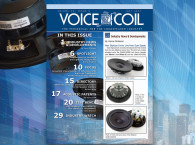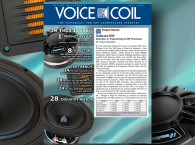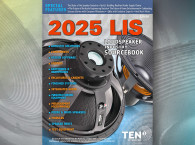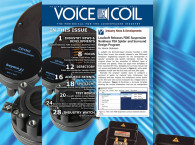 This July edition highlights a recent development by Celestion of its production-ready Axi2050 Axiperiodic Driver, which was first unveiled in 2016 and has meanwhile become commercially available. The Axi2050 wideband axiperiodic driver performs the role of two speakers in one, delivering a high power, high-output driver which reproduces a frequency range of 300 Hz to 20,000 Hz without the need for a midband crossover, and delivering an exceptionally coherent signal, enhancing clarity and speech intelligibility.
This July edition highlights a recent development by Celestion of its production-ready Axi2050 Axiperiodic Driver, which was first unveiled in 2016 and has meanwhile become commercially available. The Axi2050 wideband axiperiodic driver performs the role of two speakers in one, delivering a high power, high-output driver which reproduces a frequency range of 300 Hz to 20,000 Hz without the need for a midband crossover, and delivering an exceptionally coherent signal, enhancing clarity and speech intelligibility.
This edition focuses on Bonding, Dispensing, Coating, and Related Aspects in Speaker Production. Mike Klasco offers his unique insights and extensive experience in practical production to describe how all those critical aspects of loudspeaker manufacturing can be affected by working conditions and the choices of materials used. In the first part of an in-depth tutorial, Klasco offers a knowledgeable perspective on how to choose the right dispenser and other factors.
Following up with the Focus topic, Nora Wong (Menlo Scientific) provides an updated directory of the market leaders in Adhesives, Coatings, Sealants, and Dispenser Providers, all of which are experienced or have optimized their offerings for the speaker industry.
In this month's Spotlight, Mike Klasco writes about SoundChip, a unique solution provider for active noise cancellation product engineering. Established in 2010, the company is headquartered in Switzerland but has offices located in Manchester, England, and Hong Kong. The team has decades of product experience from its previous endeavors working with Texas Instruments (TI), Nokia, and Phitek. SoundChip operates not as consultants but as solution providers and collaborators, enabling product development teams to access a vertically integrated portfolio of technologies, IPs, devices, tools, and services, needed to reliably develop and produce, at scale, high-performance noise cancelling headphones.
In his Acoustic Patent column, James Croft (Croft Acoustical) reviews an intriguing new patent recently awarded to Stephen Wood (Poway, CA), and Elwood Norris (Poway, CA), on behalf of Turtle Beach Corp. (San Diego, CA). Basically, the new patent addresses a new emitter circuit for providing a bias voltage, which is key for the development of electrostatic loudspeakers. Extremely aware of the techniques and historical perspective of the development in this area, Croft provides a complete overview of all the challenges, implications and merits of this “Self-bias Emitter Circuit” patent and prior art. As an inventor of electrostatic loudspeaker systems and patented technology in this same area, Croft points out how instructive this new patent of "questionable novelty" is for everyone interested in the matter, and the fact that the inventors managed to get patent approval by providing more than 100 references, which the examiners where unable to verify in its entirety, missing the ones that would be able to challenge the application. It's one way to do it!
In this month's Test Bench, Vance Dickason looks at two interesting new high-frequency transducers: the 951PB, a 1.4” exit pro sound compression driver from Radian Audio Engineering, based in Orange, CA, and the TPL200/H, a horn-loaded pro sound AMT from the Valencia, Spain, company Acustica Beyma.
Voice Coil has featured several of Radian’s neodymium series of compression drivers, including the 960PB and the 950PB 2” exit aluminum diaphragm compression drivers (in the November 2014 issue), and the 745NEO with both the aluminum and beryllium diaphragms (in the October 2017 issue). For this test, Radian sent the 1.4” exit version of the previously featured 950PB, the 951PB, which share almost identical feature sets. Both have neodymium ring magnet motors, high temperature 101.6 mm (4”) diameter polyimide voice coil formers wound with copper-clad aluminum-edge wound ribbon wire voice coils, 125 W continuous power handing (250 W program power handing), a self-aligning field-replaceable diaphragm assembly, and the most important feature, a proprietary processed and hardened aerospace-grade aluminum alloy diaphragm. As Dickason confesses, he liked it so much that he ended-up using the drivers in a new studio monitor design for his own work space.
The second transducer, the TPL200/H, from Spanish OEM manufacturer Acustica Beyma, is one of the Air Motion Transformers (AMT, aka AVT Air Velocity Transformer) that Beyma has developed for pro sound applications. Part of the success of Beyma’s AMTs for pro sound comes from its proprietary X-Bow technology, which tries to open as much as possible the mechanical constraint in the diaphragm, allowing it to manage higher temperatures thus increasing the limit of the power it can handle. The Beyma TPL200/H is a Kapton horn-loaded version of the highest power handling  AMT in the Beyma AMT line and is rated at 120 W AES (24 W program), with a sensitivity of 104 dB 1 W/1 m (3 dB more than the flat faceplate version, the TPL200B/S). A very interesting driver from Beyma, which Dickason found to be on par with most high-quality compression drivers, with the power handing required of high SPL applications, and the unique sound of AMTs.
AMT in the Beyma AMT line and is rated at 120 W AES (24 W program), with a sensitivity of 104 dB 1 W/1 m (3 dB more than the flat faceplate version, the TPL200B/S). A very interesting driver from Beyma, which Dickason found to be on par with most high-quality compression drivers, with the power handing required of high SPL applications, and the unique sound of AMTs.
This edition of Voice Coil July 2018, which is now available for download and run the mail for print subscribers, concludes with the usual dose of Industry Watch updates, that any loudspeaker professional needs to be aware of.
If you already subscribe, go to - www.gotomyvcoil.com - to download this issue.
Remember, Voice Coil is available in print and download for all registered subscribers, free for industry professionals. To qualify for a free subscription to Voice Coil, or renew your subscription, go to: audioxpress.com/page/Voice-Coil-Subscriber-Services.html






